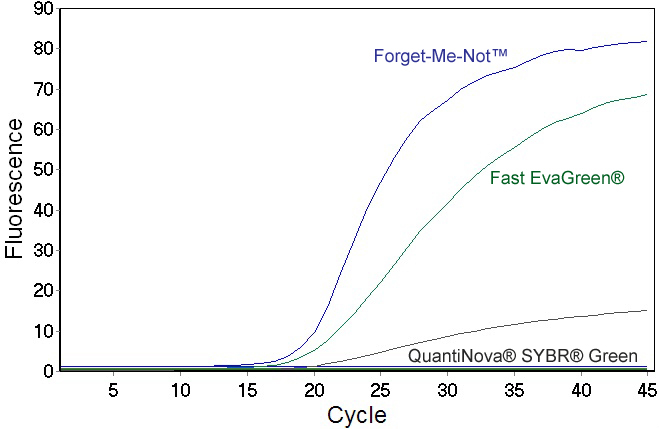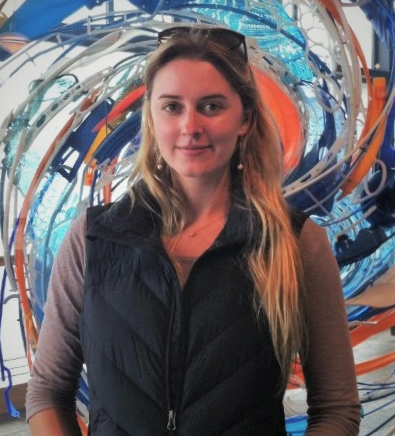Content #1
Content #1
Content #1
The development of the polymerase chain reaction (PCR) in 1983 by Kary Mullis and coworkers revolutionized molecular biology, allowing scientists to amplify DNA sequences for various applications.1 Roughly a decade later, research by Higuchi et al. led to the discovery that PCR amplification can be monitored in real time using fluorogenic nucleic acid probes, allowing for quantitative real-time PCR (qPCR).2 This technique now underpins applications like measuring levels of gene expression, rapid forms of paternity testing, scanning for mutations in target genes, and the diagnosis of many infectious diseases.
Initially, ethidium bromide (EtBr) was commonly used as a DNA-binding fluorescent dye for monitoring qPCR. Its drawbacks, including being a potential human mutagen, led to the introduction of SYBR® Green I. SYBR® Green I has brighter fluorescent signal than EtBr, but researchers soon realized that it was also a mutagen. This, along with SYBR® Green I’s propensity for background fluorescence, its inhibitory properties, and its lack of stability following multiple freeze-thaw cycles and under PCR conditions inspired Biotium scientists to develop EvaGreen® and EvaGreen® Plus Dye for qPCR. These dyes have now been helping scientists optimize their PCR, qPCR, LAMP, HRM, and ddPCR (droplet digital PCR) data for over 15 years.

Figure 1. EvaGreen® Dye binds to dsDNA via a novel “release-on-demand” mechanism.
The unique properties of EvaGreen® Dye have made it particularly useful in qPCR. Compared to SYBR® Green I, it is generally less inhibitory toward PCR and less likely to cause non-specific amplification thanks to the dye’s stronger preferential binding to dsDNA over ssDNA12. Therefore, EvaGreen® Dye can be used at a much higher dye concentration than SYBR® Green I, resulting in more robust PCR signal (Fig. 2). EvaGreen® is also compatible with multiplex PCR, as the lack of dye migration from amplicon to amplicon enables the detection of multiple PCR products by melt curves. This is thanks to EvaGreen® Dye’s higher affinity for DNA as a dimer.

Figure 2. A comparison of the raw fluorescence signal from qPCR reactions performed with two EvaGreen®-based master mixes (Forget-Me-Not™ EvaGreen® and Fast EvaGreen®) and QuantiNova® SYBR® Green I. EvaGreen® Dye is less inhibitory than SYBR® Green I, allowing for a much brighter signal.
Loop-mediated isothermal amplification’s (LAMP) simplicity and speed make the method particularly attractive for point-of-care diagnostics in resource-limited contexts. It also shines in field settings where it’s used for rapid detection of plant pathogens or infectious disease agents like malaria, tuberculosis, and SARS-CoV-2.10, 11 Both LAMP and PCR amplify DNA, but there are a few key differences:
HRM® is a post-PCR method for analyzing the melt curves of amplified DNA fragments. The method requires a DNA binding dye like EvaGreen®, and an instrument with exceptional thermal sensitivity that can distinguish melt curves between fragments with small sequence variations. The analysis can be used for DNA mapping, mutation scanning, species identification, zygosity testing, DNA fingerprinting, and more.
Despite its popularity, SYBR® Green I has been found to be unreliable for HRM® due to problems caused by dye redistribution at higher concentrations. EvaGreen® was designed to be less inhibitory in the PCR reactions, permitting the use of saturating dye concentration for maximal signal and better high-resolution DNA melt analysis with less dye redistribution. 5,6
Droplet digital PCR (ddPCR) is a digital PCR method that is based on water-oil emulsion droplet technology. The sample is fractionated into tens of thousands of droplets, which act as individual test tubes or wells in a plate in which the PCR reaction takes place. The technique allows researchers to multiplex targets from the same sample and requires smaller sample amounts than other commercially available digital PCR systems. This results in lower sample and reagent volume requirements and reduced overall cost while maintaining the sensitivity and precision of digital PCR. Digital PCR techniques, like ddPCR, also offer the ability for absolute quantification of molecules.
TaqMan® probes have traditionally been used for this technique, but their expense and the required complexity in assay design are significant drawbacks. EvaGreen® is less likely to inhibit PCR and promote mispriming than competitor DNA-binding dyes, and it shows superior performance when used in qPCR and for high resolution melt curve analysis. This makes it a promising tool for ddPCR. McDermott et al. confirmed its effectiveness in their 2013 paper in which they identified EvaGreen® as the only DNA-binding dye validated for ddPCR in their experimental system. In this study, they also found that EvaGreen® increased resolution and allowed for the quantification of multiple target species in a single well of droplets.9
DNA-binding dyes are inherently dangerous due to their potential to cause mutations. Ohta et al. found SYBR® Green I to be even more environmentally toxic than ethidium bromide, a well-known mutagen.13 No safety data currently exists on other common PCR and HRM dyes (e.g., SYTO®9, LCGreen®, BRYT Green®, and ResoLight). However, these dyes are known for quickly permeating cells and posing a potential risk of genotoxicity. This motivated Biotium scientists to create EvaGreen®, a dye that is impenetrable to latex gloves and cell membranes, with metabolites that have little or no interaction with DNA. Testing by Biotium and independent testing services confirmed that it is noncytotoxic and nonmutagenic at concentrations well above the working concentrations used in qPCR.

Julianne Davis earned an MSc in Behavioral Neuroscience from the University of Washington, Seattle, where she examined the role of memory in cost-based decision-making. She has also studied sensory integration at the Allen Institute and the neural basis of feeding, thirst, and metabolism at the University of California, San Francisco as a research scientist. Currently, she is a Technical Writer and Support Scientist at Biotium.